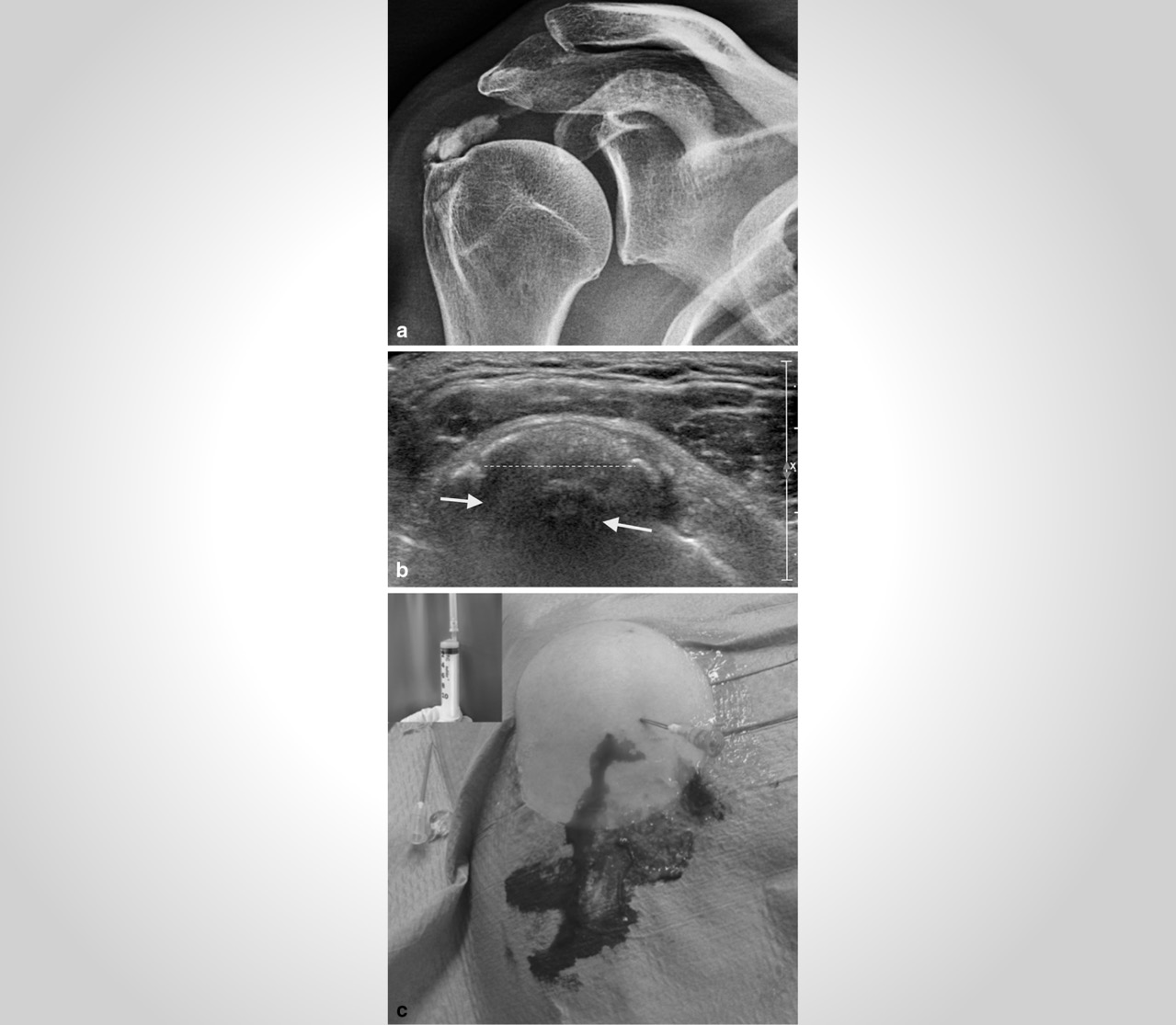Calcific tendinitis in the shoulder
It occurs when one or more of the shoulder tendons are irritated and calcium deposits have formed in the tendons.
Other synonyms
- Calcific tendinopathy
- Shoulder calcification
- Calcified tendon
- Calcium deposit in the shoulder
What is the difference between tendinitis and tendinopathy?
The two are almost identical. Science has recently discovered that there is not always inflammation present in tendon pain.
"So when there is tendon pain without inflammation, it is called tendinopathy. When there is tendon pain with inflammation of the tendon, then it is called tendinitis."
In both cases, whether it is tendinitis or tendinopathy, the management is similar. Therefore, we will include tendinopathies and tendinitis as being the same injury.
What is calcific tendinitis?
It occurs when one or more of the shoulder tendons are irritated and calcium deposits have formed in the tendons.

What is a tendon?
A tendon is the structure that attaches the muscle to the bone. When a muscle contracts, the force is transmitted to the tendon, and the tendon stiffens to move the bones.
What is calcification?
Calcification of a tendon is a deposit of fluid containing calcium. This deposit is located on the tendon.
Many people mistakenly believe that a calcification or calcium deposit is the equivalent of having a rock or a piece of bone in the tendon. It is true that on an X-ray it looks like a bone since both are made of calcium. The difference is that in calcific tendinitis, the calcification is actually a fluid containing calcium. So it's not hard like a bone. In fact, it's not hard at all.
What are the causes of calcific tendinitis?
The presence of calcium on one or more tendons is generally due to a tendon wear process and occurs over a period of time. Therefore, this injury can develop as a result of:
- Repetitive shoulder movements with the arms in the air
- Overload on the shoulder muscles (after a new sport or moving, for example)
What are the risk factors for developing calcific tendinitis?
Certain factors can increase the chances of developing calcific tendinitis, such as:
- Being between 40 and 60 years old
- Women are more affected than men
- Being diabetic
- Having a job that requires lifting heavy loads
- Being an athlete who plays sports with their arms raised above their shoulders (volleyball, tennis, badminton, baseball, handball, etc.)
What are the symptoms of calcific tendinitis?
The most common symptoms are:
- Specific pain in the shoulder that has appeared gradually (the pain is often in the front or on the side and can radiate down the side of the arm)
- The pain is often worse in the morning upon waking
- Shoulder weakness and pain when lifting loads
- Shoulder pain and stiffness when raising your arms overhead

How is calcific tendinitis diagnosed?
Diagnosis is possible based on a history of symptoms and a clinical examination. An X-ray can show whether there are calcium deposits on the shoulder tendons.
When should I see a physiotherapist for calcific tendinitis?
You should consult a physiotherapist if you have symptoms as described above or if your doctor has already ruled out any other cause that may be responsible for your pain.
You do not need to see a doctor before consulting a physiotherapist. If your condition requires you to see a doctor, your physiotherapist will be able to tell you.
What physiotherapy treatments are available for calcific tendinitis?
Your physiotherapist will perform an assessment to determine why your tendon hurts. To do this, they will evaluate the following elements:
- Your joint mobility
- The gliding of your nerves
- The quality of your movements
- Your strength and stability
Based on the assessment results, your physiotherapist will:
- Mobilize your shoulder to reduce pain and improve your range of motion.
- Give you specific exercises to increase shoulder mobility, reduce pain, and improve control of your movements and muscle strength.
- Teach you how to properly manage your daily activities and hobbies to optimize healing
- Give you advice for your posture and movements.
What can I do at home for calcific tendinitis?
Temporarily stop doing movements that cause too much pain, and then gradually start doing them again.
Here are some other tips to help you:
- If you have pain at night or morning stiffness, make sure your neck is well supported while sleeping with a pillow that fills the hollow of your neck.
- Avoid sleeping with your arm behind your head or under the pillow. Keep your arm along your body or supported with a pillow.
- Avoid sleeping on the painful shoulder.
- If you can't find a comfortable position for the night, use one or two pillows to support your arm.
If you don't see any improvement after 10 days, you should consult a physiotherapist.
Did you know?
- In a good proportion of cases, the calcium deposits will disappear on their own as the body absorbs these deposits.
Sources
De Carli A, Pulcinelli F, Delle Rose G, Pitino D, Ferretti A. Calcific tendinitis of the shoulder. Joints. 2014 Jul;2(3):130.
Videos in this category
Other conditions
Hip osteoarthritis is a normal wear and tear of the hip joint. Osteoarthritis is often described as the wearing away of cartilage between our bones. While this is true, it involves more than just cartilage. Cartilage is a tissue that acts like a cushion between the surfaces of our bones, allowing our joints to glide smoothly and move with ease.
It is a normal wear and tear of the knee joint. Osteoarthritis is often described as the wearing away of cartilage between our bones. While this is true, it involves more than just cartilage. Cartilage is a tissue that acts like a cushion between the surfaces of our bones, allowing our joints to glide smoothly and move with ease.
It is a normal wear and tear of the joints in the lower back vertebrae. Osteoarthritis is often described as the wearing away of cartilage between our vertebrae. While this is true, it involves more than just cartilage. Cartilage is a tissue that acts like a cushion between the surfaces of our vertebrae, allowing them to glide smoothly and move with ease.
A bursa is like a small, very thin, fluid-filled sac found in several joints throughout the body. This small sac acts as a cushion in the joint and lubricates structures that are exposed to more friction.
It is an inflammation of the subacromial bursa in the shoulder joint.
It is a tissue that surrounds the shoulder and allows the shoulder bone to stay in place within the joint. The capsule helps to stabilize the joint.
Cervicalgia is a general term to describe neck pain that does not have a specific cause, such as an accident or sudden movement. Cervicalgia is therefore synonymous with ''I have a pain in my neck and nothing in particular happened''.
In both injuries, there is pain felt in the neck that then radiates into the arm, or vice versa.
It is a significant stretch or tear of the muscle fibers in the groin or inner thigh muscles.
It is a significant stretch or tear of the muscle fibers in the hamstring muscles located at the back of the thigh.
This is a significant stretch or tear of the muscle fibers in the calf muscles (soleus and gastrocnemius).
This is a significant stretch or tear of the muscle fibers in the quadriceps, which is the large muscle at the front of the thigh.
Book an appointment now
We offer a triple quality guarantee: optimized time, double physiotherapy assessment, and ongoing expertise for effective care tailored to your needs.


Our clients' satisfaction is our priority.
At Physioactif, excellence defines our approach. But don't take our word for it, see what our patients are saying.
Discover our physiotherapy clinics
We have multiple locations to better serve you.
Blainville
190 Chem. du Bas-de-Sainte-Thérèse Bureau 110,
Blainville, Quebec
J7B 1A7
Laval
Montreal
St-Eustache
Vaudreuil
21 Cité-des-Jeunes Blvd. Suite 240,
Vaudreuil-Dorion, Quebec
J7V 0N3
Book an appointment now

